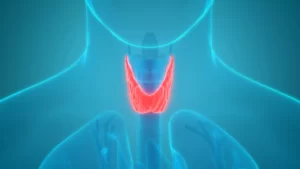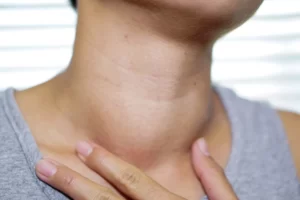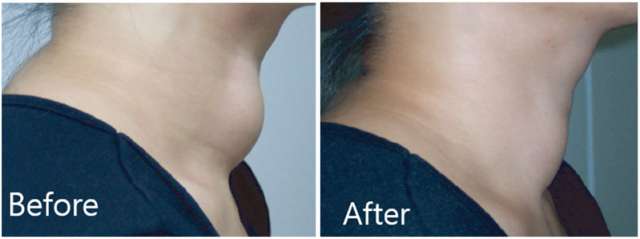Thyroid Nodules & Surgery
Home | Services | Head And Neck | Thyroid Nodules
Thyroid Specialist In Singapore / Thyroid Surgeon
Dr. Leslie Koh is an thyroid surgeon Singapore and thyroid specialist in Singapore. Thyroid nodules, both symptomatic and asymptomatic are common in Singapore, and the rate of cancer in these nodules has been increasing. See a thyroid doctor in Singapore today!
Understanding the Thyroid Gland
The thyroid is a butterfly-shaped gland located in the lower front of the neck, just below the voice box (larynx). It plays a vital role in regulating metabolism, body temperature, and heart rate through the production of hormones such as thyroxine (T4) and triiodothyronine (T3).
In Singapore, thyroid disorders are relatively common and can affect individuals of all ages, particularly women. Early detection and management are essential to prevent complications and maintain overall health.
Common Thyroid Conditions Managed by an ENT Thyroid Surgeon
Thyroid conditions may present with a range of symptoms or remain silent. ENT thyroid surgeons with training in head and neck surgery are involved in the assessment and management of thyroid-related concerns, particularly when surgical intervention is required.
1. Thyroid Nodules
These are lumps that form within the thyroid gland. While most are non-cancerous, some may require further evaluation to exclude malignancy.
2. Goitre
Goitre refers to the abnormal enlargement of the thyroid gland. It can cause visible swelling in the neck and may sometimes lead to breathing or swallowing difficulties.
3. Thyroid Cancer
Certain types of nodules may be malignant. Papillary thyroid carcinoma is the most common form of thyroid cancer in Singapore. Surgical removal is often part of the management plan.
4. Hyperthyroidism and Hypothyroidism
While typically managed by endocrinologists, ENT specialists may be involved when there are associated nodules, goitre, or surgical considerations.
What Are Thyroid Nodules?
 A thyroid nodule, or a lump in thyroid is an area of abnormal growth within the thyroid gland. The thyroid gland is a butterfly-shaped gland located at the base of the front of the neck. It produces thyroid hormone, which controls your metabolism, temperature regulation, and keeps your muscles and organs working properly.
A thyroid nodule, or a lump in thyroid is an area of abnormal growth within the thyroid gland. The thyroid gland is a butterfly-shaped gland located at the base of the front of the neck. It produces thyroid hormone, which controls your metabolism, temperature regulation, and keeps your muscles and organs working properly.
Thyroid disease, whether functional (hypothyroidism, hyperthyroidism) or structural (nodule, goiter, cancer), occur very commonly. Some people have a single nodule while others have multiple nodules within the gland. Thyroid nodules, which are particularly common in women, can be tiny, to very large in size which may make it difficult to swallow or breathe.
What Are The Symptoms Of A Thyroid Nodule?
Most thyroid nodules are non-cancerous, do not cause symptoms, and do not need any treatment. In some cases, however, because of the size, appearance (on radiology tests), or symptoms caused by the nodule, additional evaluation and treatment may be needed. The presence of a family history of thyroid cancer, exposure to radiation and some suspicious features on physical exam / ultrasound scan can
increase the likelihood of thyroid cancer in a thyroid nodule.

Most thyroid nodules do not cause symptoms. Often, thyroid nodules are discovered incidentally during a routine physical examination or on imaging tests like CT scans or neck ultrasound done for completely unrelated reasons. Occasionally, patients themselves find thyroid nodules by noticing a lump in their neck while looking in a mirror, buttoning their collar, or fastening a necklace. Abnormal thyroid function tests may occasionally be the reason a thyroid nodule is found.
Thyroid nodules may also produce excess amounts of thyroid hormone causing hyperthyroidism. However, most thyroid nodules, including those that cancerous, are actually non-functioning, meaning blood tests are usually normal. Rarely, patients with thyroid nodules may complain of pain in the neck, jaw, or ear. If a nodule is large enough to compress the windpipe or esophagus, it may cause difficulty with breathing, swallowing, or cause a “tickle in the throat”. Even less commonly, hoarseness can be caused if the nodule invades the nerve that controls the vocal cords but this is usually related to thyroid cancer.
How Are Thyroid Nodules Investigated?
The following tests can be performed to aid in diagnosis and treatment of thyroid disorders:
- Blood tests, specifically Thyroid Function Tests (TFT)
- Nasoendoscopy to evaluate the movement of the vocal cords
- Imaging, specifically a thyroid ultrasound to evaluate the size and appearance of the nodule, and whether there are any suspicious features. These nodules may be:
- filled with fluid (i.e. thyroid cyst)
- have both solid and fluid components (i.e. solid-cystic nodule),
- have only a solid component (i.e. solid nodule)
- Thyroid scans (radionuclide) of the thyroid gland to ascertain whether the nodule is ‘hot’ or ‘cold’, i.e. functioning or non-functioning
- A fine needle aspiration biopsy (FNA), which is a safe, relatively painless procedure. In this procedure, a small needle is passed into the lump, and tissue samples containing cells are taken and then sent to a pathologist for testing.

What Results Can I Expect From A Fine Needle Aspirate Biopsy (FNA)?
The report of an FNA biopsy will usually indicate one of the following findings:
The nodule is benign (noncancerous)
This result is obtained in up to 80% of biopsies. The risk of overlooking a cancer when the biopsy is benign is generally less than 3%. Generally, benign thyroid nodules do not need to be removed unless they are causing symptoms like choking or difficulty swallowing. Follow-up ultrasound exams are important. Occasionally, another biopsy may be required in the future, especially if the nodule grows over time.
The nodule is malignant (cancerous) or suspicious for malignancy.
A malignant result is obtained in about 5% of biopsies and is most often due to papillary thyroid cancer, which is the most common type of thyroid cancer. A suspicious biopsy has a 50-75% risk of cancer in the nodule. These diagnoses will most likely require require surgical removal of the thyroid.\
The nodule is indeterminate.
This is actually a group of several diagnoses that may occur in up to 20% of cases. An indeterminate finding means that even though an adequate number of cells was removed during the fine needle biopsy, examination with a microscope cannot reliably classify the result as benign or malignant.
The biopsy may be indeterminate because the nodule is described as a Follicular Lesion. These nodules are cancerous 20-30% of the time. However, the diagnosis can only be made by surgery. Since the odds that the nodule is not a cancer are much better here (70-80%), only the side of the thyroid with the nodule is usually removed. If a cancer is found, the remaining thyroid gland usually must be removed as well. If the surgery confirms that no cancer is present, no additional surgery to “complete” the thyroidectomy is necessary.
The biopsy may also be indeterminate because the cells from the nodule have features that cannot be placed in one of the other diagnostic categories. This diagnosis is called atypia, or a follicular lesion of undetermined significance. Diagnoses in this category will rarely contain cancer. However, surgical biopsy to remove half of the thyroid containing the nodule is usually recommended.
The biopsy is non-diagnostic or inadequate
This result is obtained in less than 5% of cases when an ultrasound is used to guide the FNA. This result indicates that not enough cells were obtained to make a diagnosis but is a common result if the nodule is a cyst. These nodules may require reevaluation with second fine needle biopsy, or may need to be removed surgically.
How Are Thyroid Nodules Treated?
Thyroid nodules that are found to be cancerous or highly suspicious for cancer are usually treated with surgery. Removal of one half of the thyroid gland is known as a hemithyroidectomy, while removal of the entire gland is termed a total thyroidectomy. Most thyroid cancers, when detected early, can be effectively managed.
Nodules that appear benign on fine needle aspiration (FNA) biopsy or are too small to biopsy are often monitored over time. Regular follow-up with ultrasound imaging every 6 to 12 months is recommended to detect any changes in size or appearance.
In certain cases, thyroid surgery may still be advised for a nodule that appears benign if it continues to grow or develops new features on ultrasound that warrant further investigation.
Post-operative radioactive iodine therapy may be considered in some individuals with thyroid cancer, depending on the type and extent of disease.
Surgical Options for Thyroid Conditions
Surgery may be recommended for thyroid conditions under the following circumstances:
- Suspicion or confirmed diagnosis of thyroid cancer
- Presence of pressure symptoms such as difficulty breathing or swallowing
- Cosmetic concerns related to an enlarged goitre
- DNon-resolving nodules or recurrent cysts
Common thyroid surgical procedures include:
- Hemithyroidectomy: removal of one lobe of the thyroid gland
- Total thyroidectomy: removal of the entire thyroid gland
The type of procedure recommended depends on factors such as the diagnosis, size of the nodule, location, and the individual’s overall health. These options will be discussed thoroughly during the consultation, allowing for informed decision-making.
What Are Some Risks Of Thyroid Surgery?
Complications of thyroid surgery are uncommon, and may include:
- Infections of the wound and wound site
- Bleeding from the wound site and surgical bed
- Temporary hoarseness and throat discomfort
- Injury to the surrounding structures such as the windpipe, foodpipe, and large blood vessels in the neck
- Injury to the nerves supplying the voice box, which may result in a permanently hoarse voice and / or a deepening of the tone of the voice
- Injury to glands which secrete calcium which are attached to the thyroid gland; this may result in low calcium levels requiring calcium supplementation
What Is Thyroid Radiofrequency Ablation (RFA)?
Thyroid radiofrequency ablation is an outpatient procedure, done either under local anaesthesia or sedation. During this procedure, a small needle with a radiofrequency electrode at the tip, is inserted into the thyroid nodule under image guidance. Heat generated at the needle tip destroys the target tissue. It is a procedure that is a potential alternative to surgery for treating symptomatic benign thyroid nodules.
What Are The Indications For Thyroid Radiofrequency Ablation?
Radiofrequency ablation of the thyroid is most commonly used for the treatment of thyroid disorders and nodules which are or have been / are:
- biopsy-proven to be benign,
- solid (or predominately solid) thyroid nodules which cause pressure or cosmetic problems. .
Other indications include the treatment of functioning thyroid nodules (‘hot nodules’) as an alternative to surgery or radioactive iodine treatment.
In certain circumstances, small primary thyroid or recurrent thyroid cancers, which are not located near critical structures, can be treated with RFA in patients who are adverse to surgery or who may not be good surgical candidates due to comorbid medical conditions.
What Is The Thyroid RFA Procedure Like?
The procedure typically lasts about one hour and the duration is dependent on the size of the nodule being treated.
Patients leave the hospital on the same day. Post-operatively, some patients experience may minor discomfort and bruising which may be treated with simple pain medications. There are no scars from the procedure.
What Can I Expect After Thyroid RFA?
Patients usually notice a decrease in the size of the nodule approximately one month after the procedure. This shrinkage will continue with time until the nodule is significantly smaller. However, complete resolution of the nodule is not expected. Some patients with large nodules may require additional thyroid RFA treatments to achieve optimal reduction in size.

FAQs about Thyroid in Singapore
1. What is the difference between an ENT thyroid surgeon and an endocrinologist?
An endocrinologist primarily manages thyroid hormone disorders medically, while an ENT thyroid surgeon is involved when there is a need for surgical assessment or removal of part or all of the thyroid gland.
2. Are all thyroid nodules cancerous?
No. Most thyroid nodules are benign. However, further tests such as an ultrasound and FNA biopsy help determine whether further action is needed.
3. Will I need to take medication after thyroid surgery?
This depends on how much of the thyroid gland is removed. Some individuals may require long-term thyroid hormone replacement therapy, especially after a total thyroidectomy.
4. How long is the recovery after thyroid surgery?
Recovery time varies, but most individuals return to normal activities within 1–2 weeks. Full healing of the surgical site may take several weeks.
5. Is thyroid surgery painful?
Pain is usually mild and well-managed with oral medications. Most patients are discharged within a day or two post-surgery.
- Thyroid nodules
- Cancer of the Thyroid
- Salivary Gland lumps
- Salivary Gland and/or Salivary Duct Stones
- Enlarged Cervical Lymph Nodes
- Cancers of the Head and Neck Region
- Nasopharyngeal Cancer (NPC)
- Lesions in the Mouth & Oral Cavity
- Hemi / Total Thyroidectomy
- Salivary gland removal (submandibular / parotid gland)
- Removal of salivary duct stones
- Excision of Cervical Lymph Nodes
- Excision of Mouth & Oral Cavity Lesions








